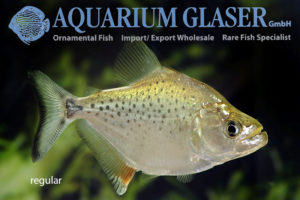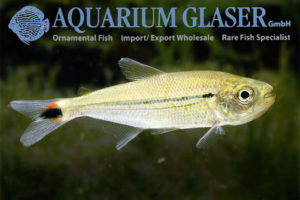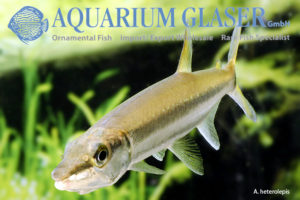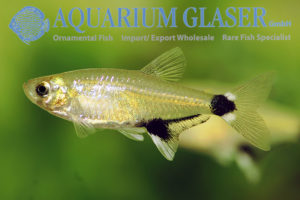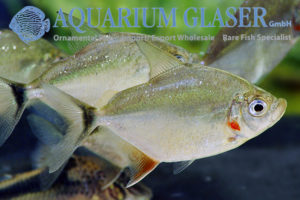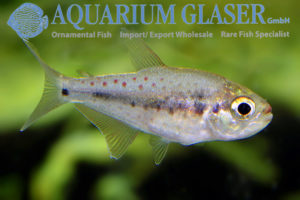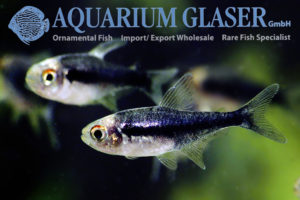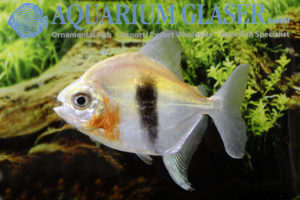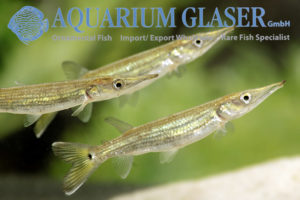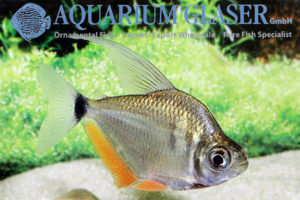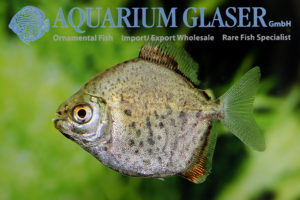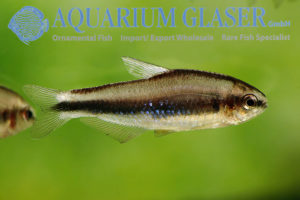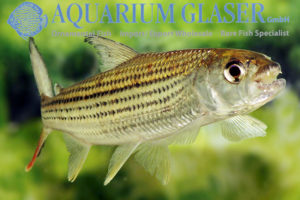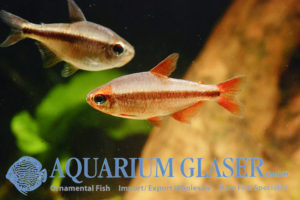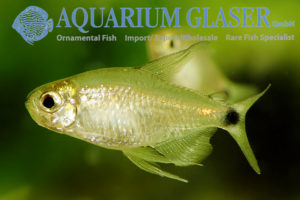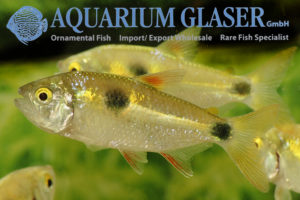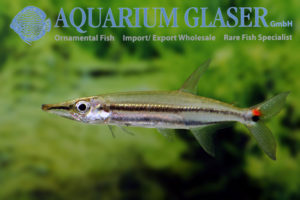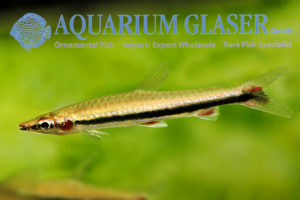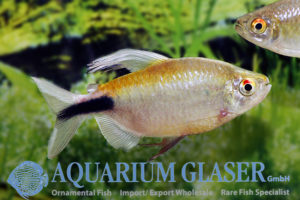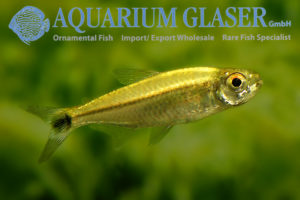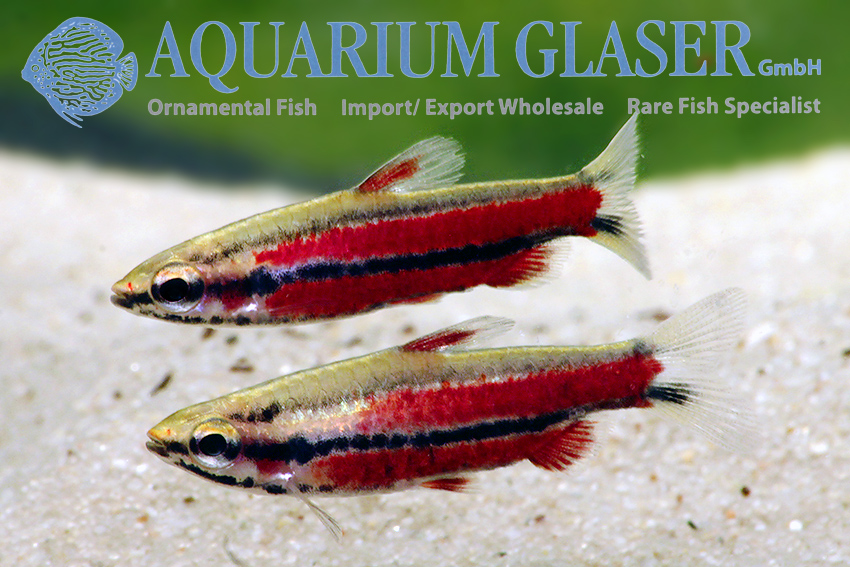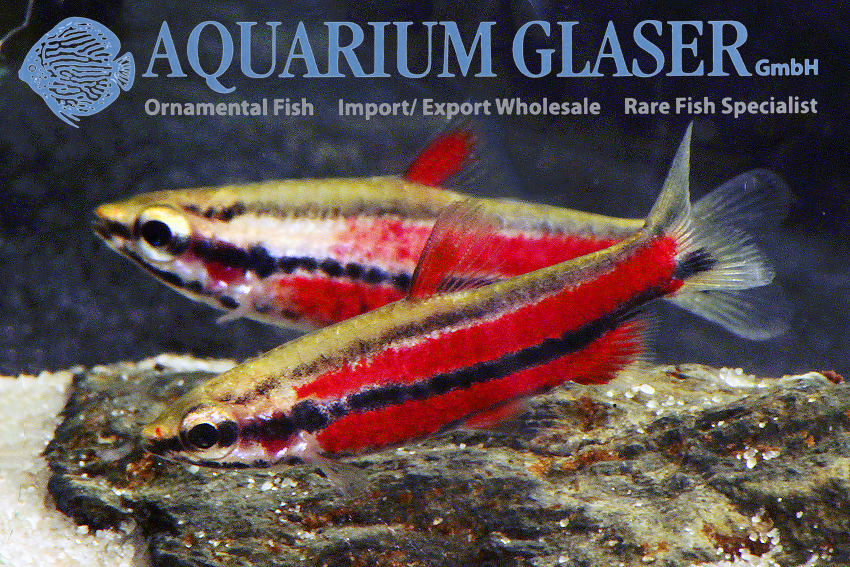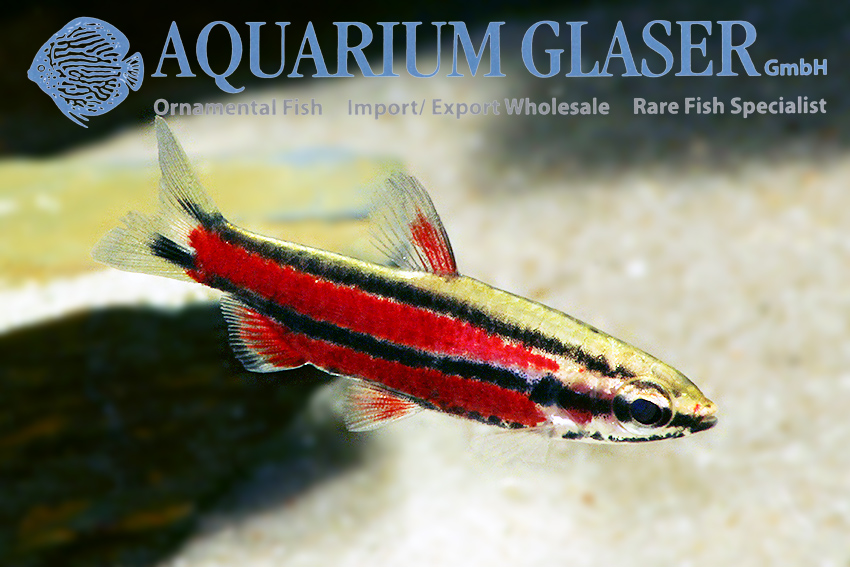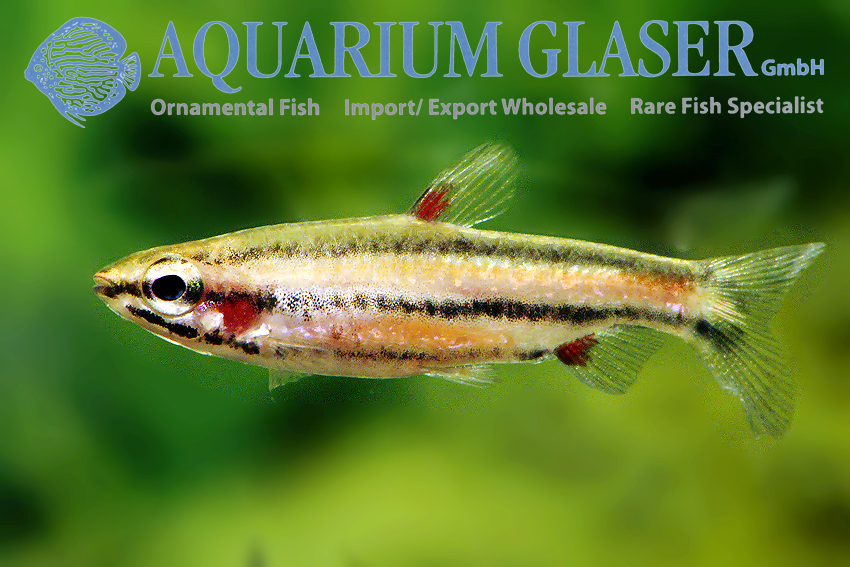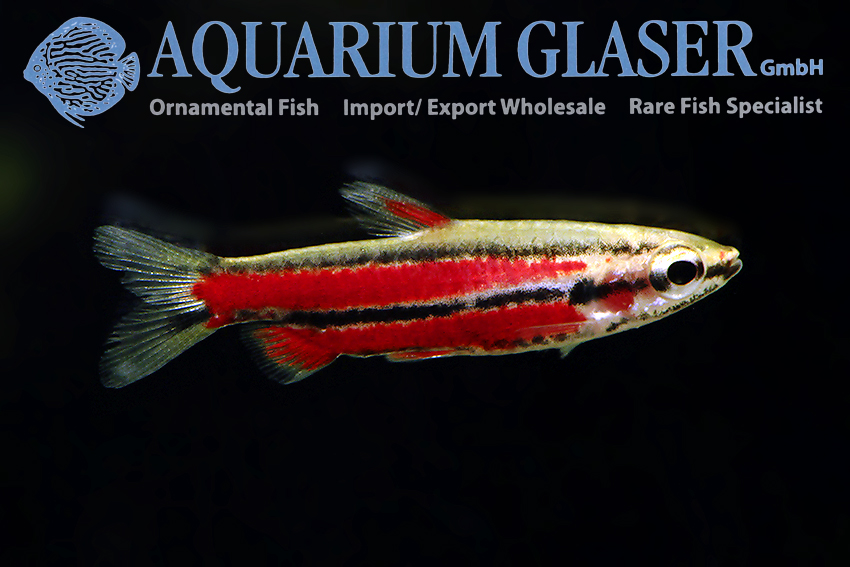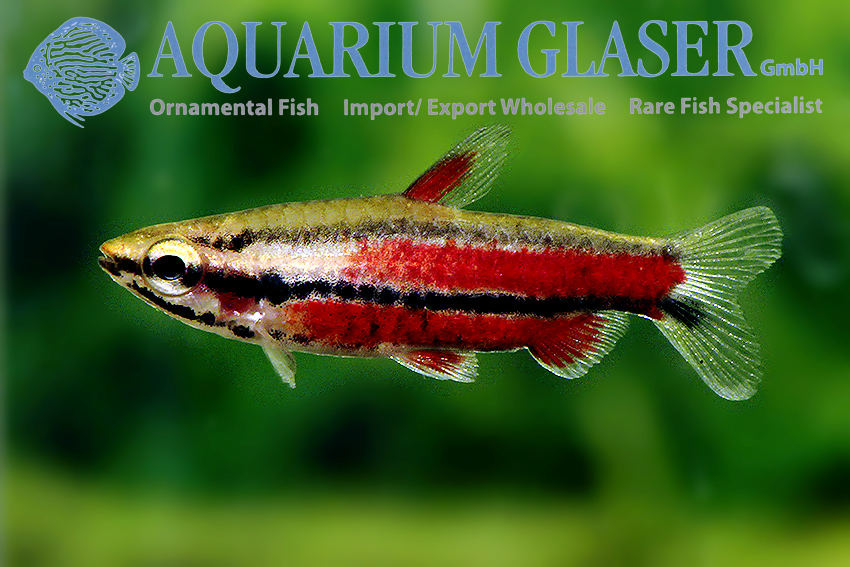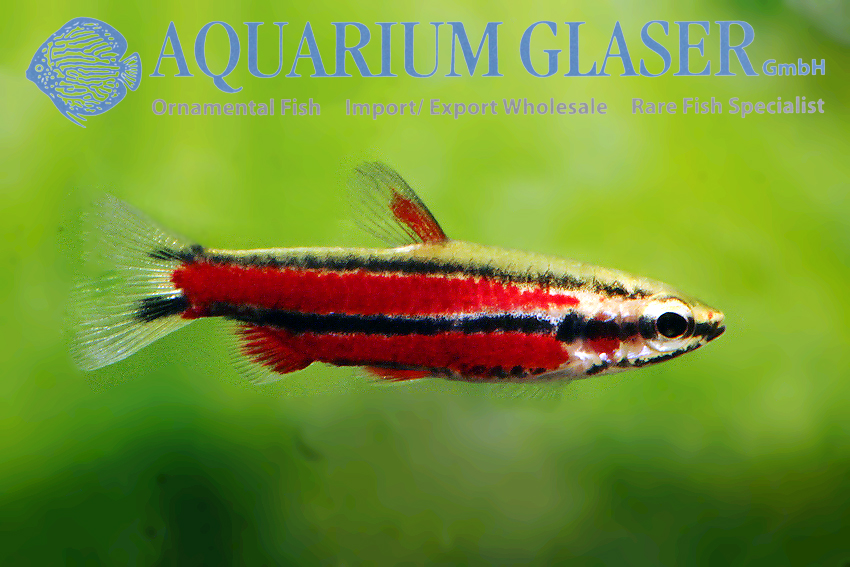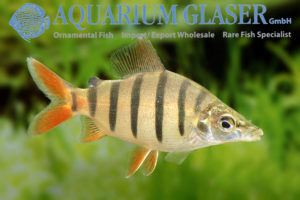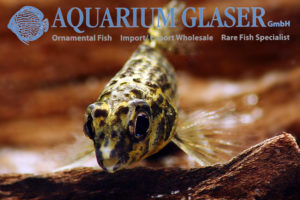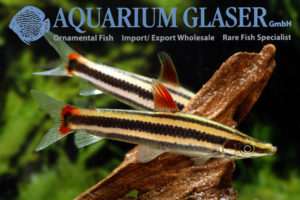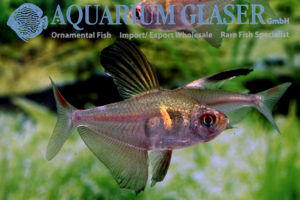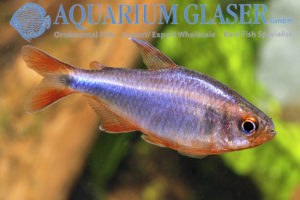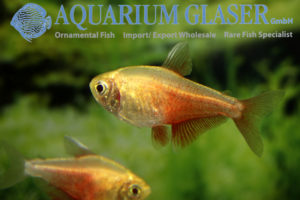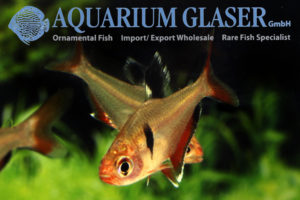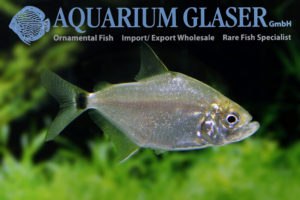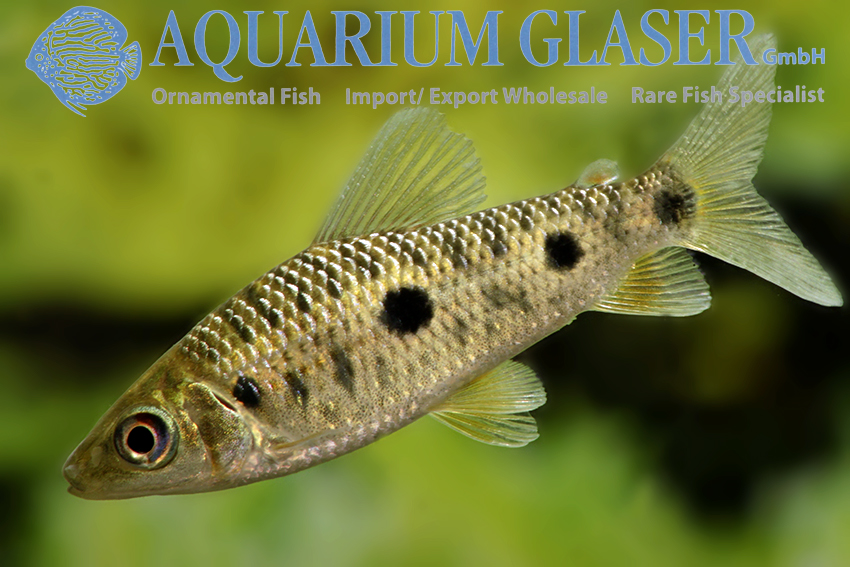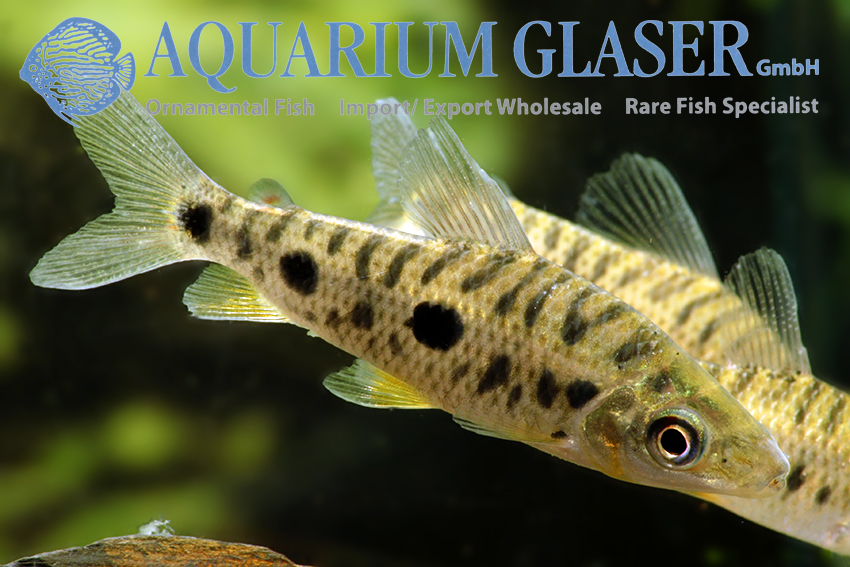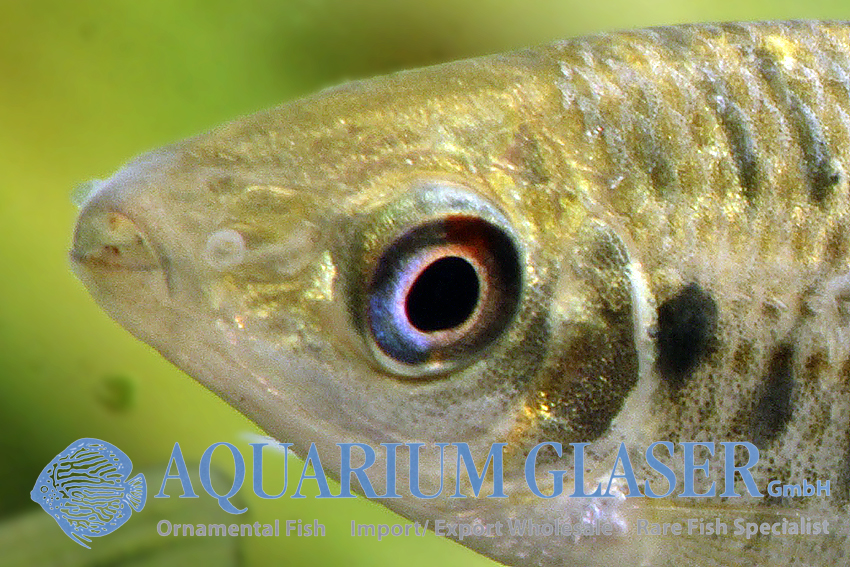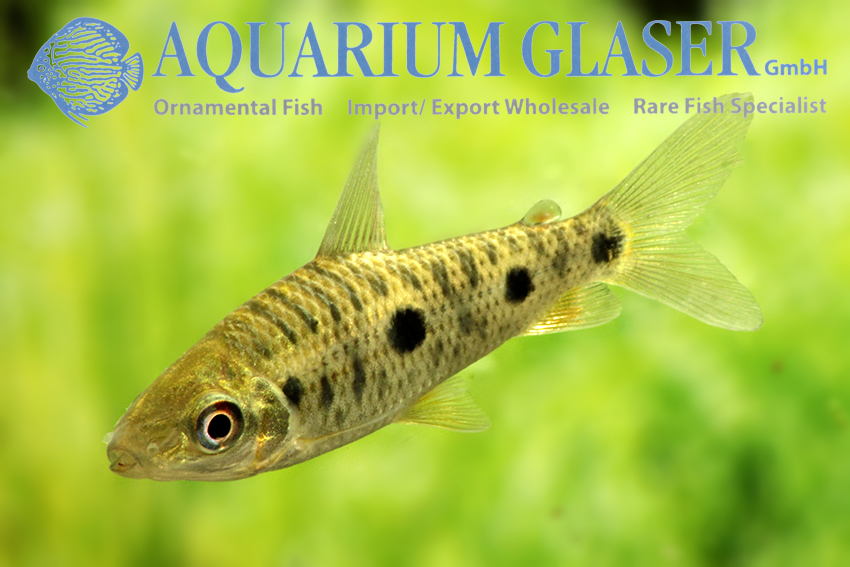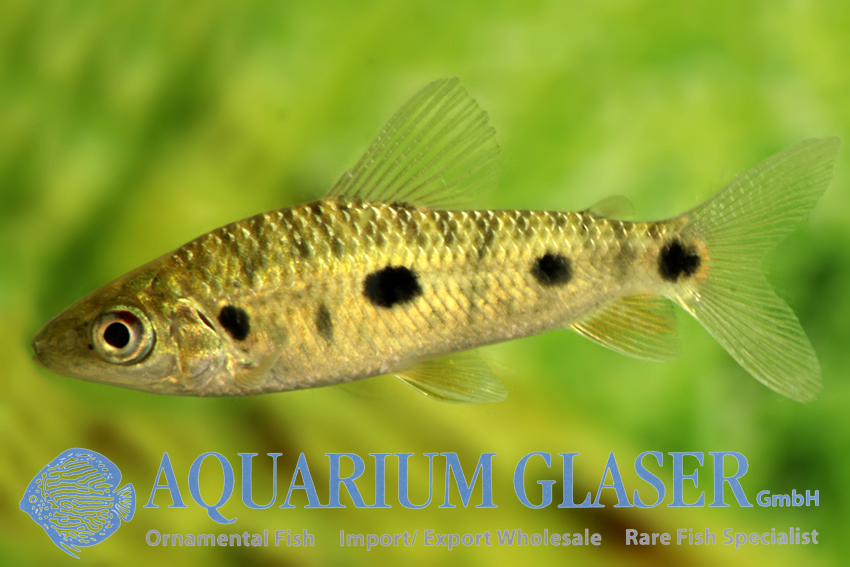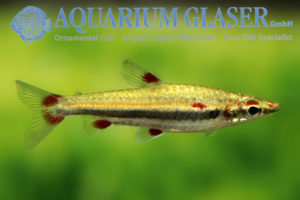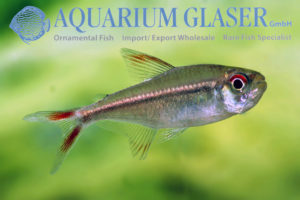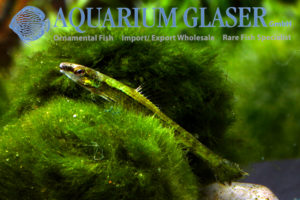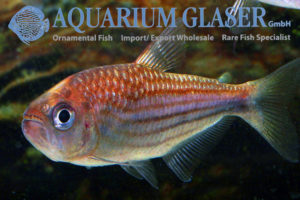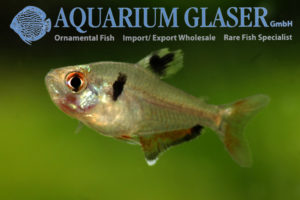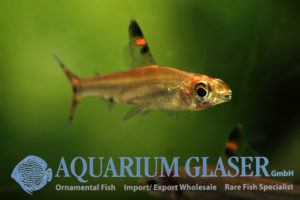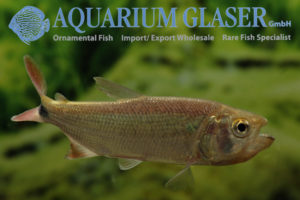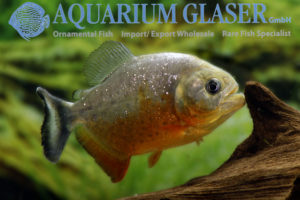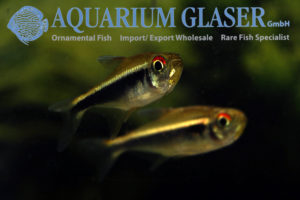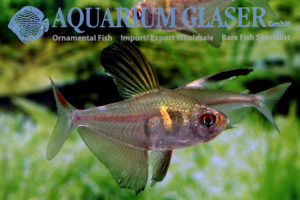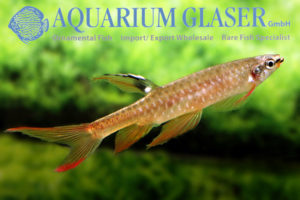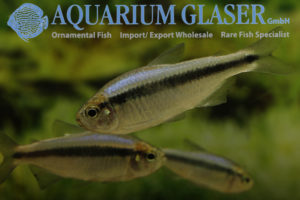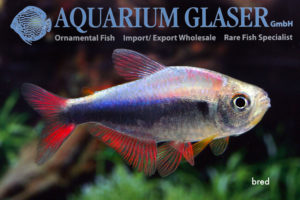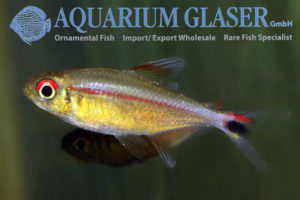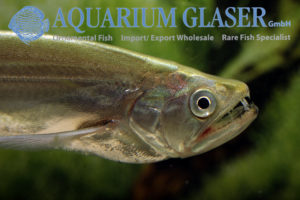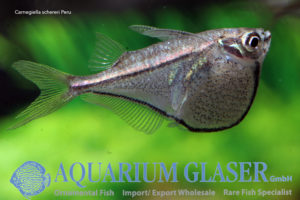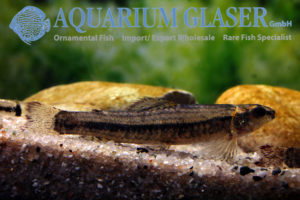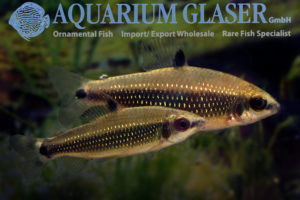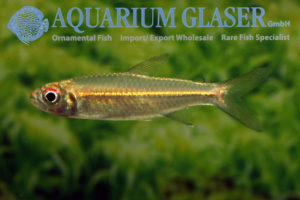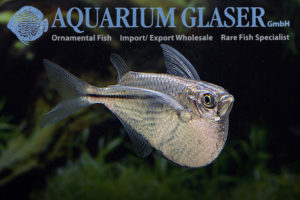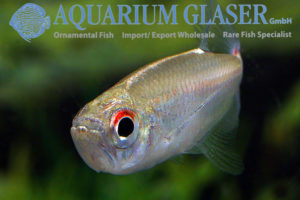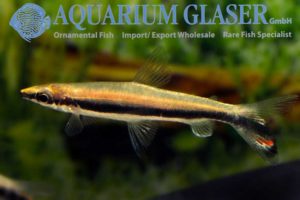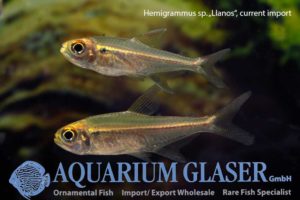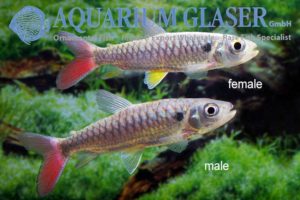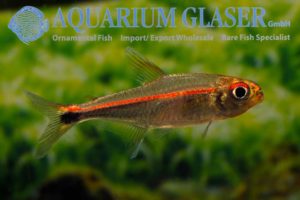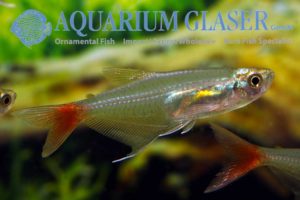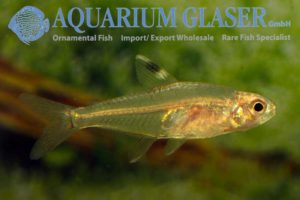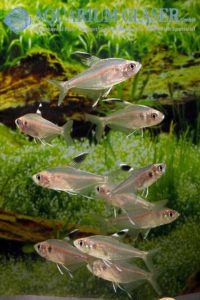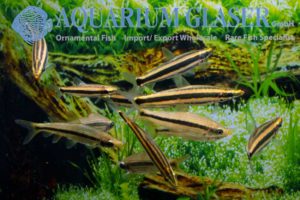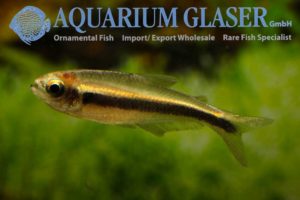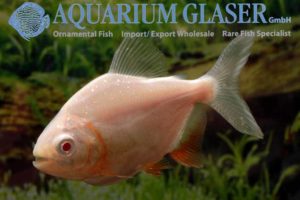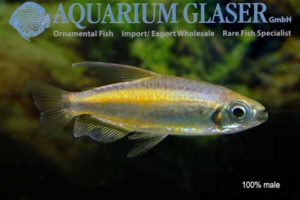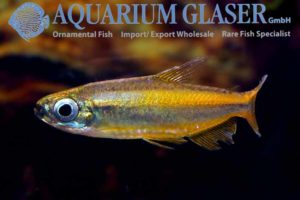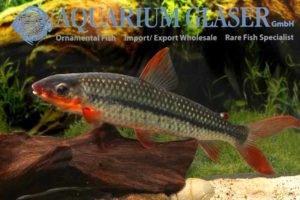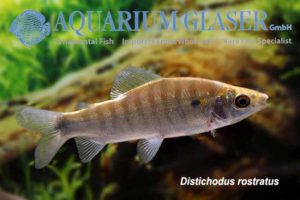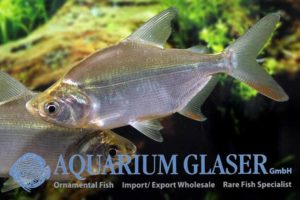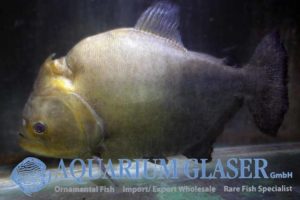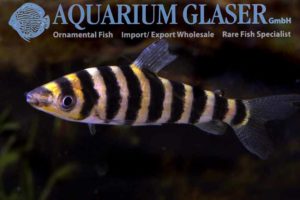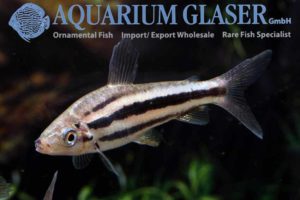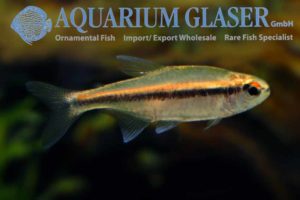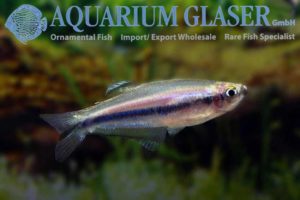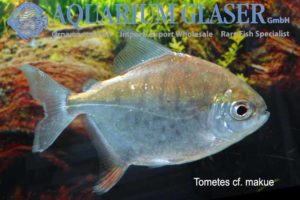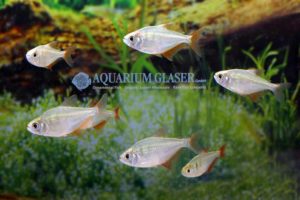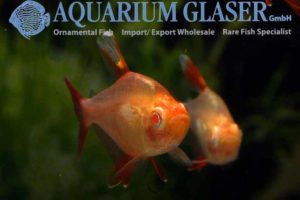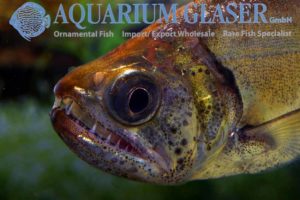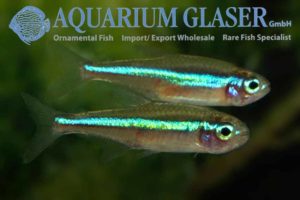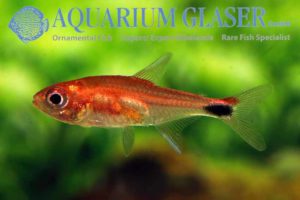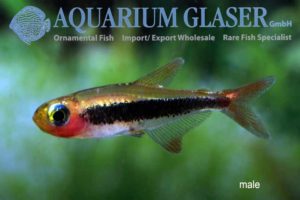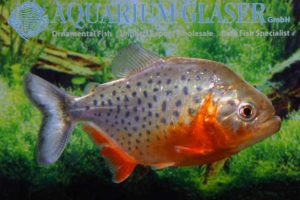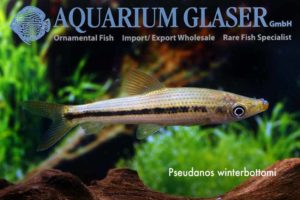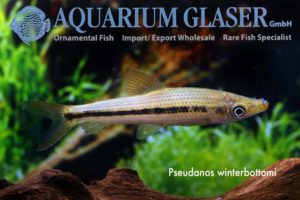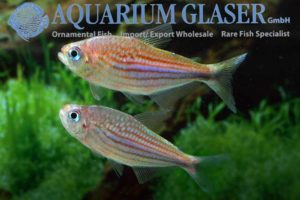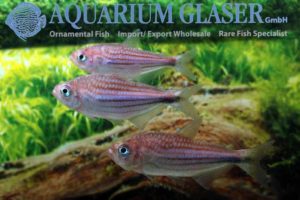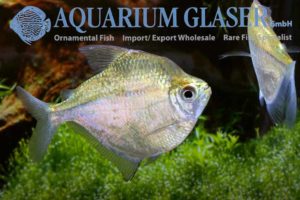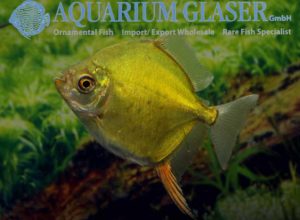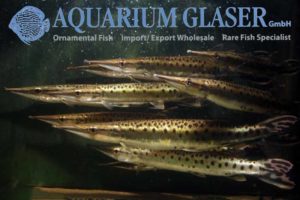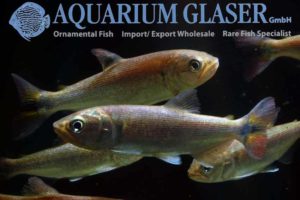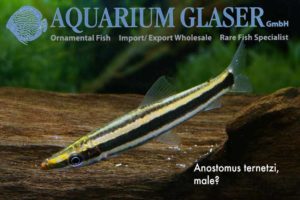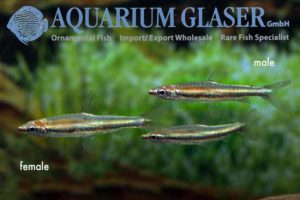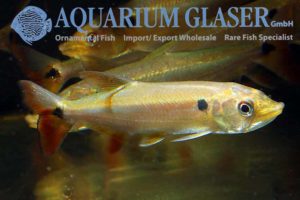Recently we obtained a shipment of piranhas from Peru. The fish are 5-9 cm long. At the first glimpse the shipment could be told apart into two phenotypes. First, there were fish with comparatively small spots, a lot of red coloration in the anal fin and a comparatively thin black border on the caudal fin. […]
09. Characoids: tetra relationship (488)
-
-
Jupiaba sp. „Cherry Spot“
We were able to import a new species of tetra from Venezuela which does not resemble to any species known to us. According to the collector the animals were collected in small brooks in the surroundings of Puerto Inirida. There are no doubts that our new imports belong to the Astyanax relationship in the broadest […]
-
Acestrorhynchus heterolepis and A. microlepis
For the first time we were able to import Acestrorhynchus heterolepis, which has been described scientifically as early as 1878 by Cope from Peru. Our specimens originate from Venezuela; it was a mixed shipment of these fish and A. microlepis*. A. heterolepis has two dark horizontal bands, thus reminding a bit in A. isalinae; however, […]
-
Aphyocharax paraguayenis
This small, about 4.5 cm maximum length reaching tetra belongs to the most attractive species of tetra at all. The species is very hardy and undemanding and can be easily bred in huge numbers. It is a fish of the subtropical regions and doesn´t even require a heater. In the wild, water temperatures between 16 […]
-
Catoprion mento
Photos: Frank Schäfer
-
Pseudochalceus kyburzi
After many years we finally were able again to import this very beautiful tetra from Colombia once more. This species attains usually a length of about 5 cm, the largest one reported had about 8 cm in length. In respect of the general look and the behaviour Pseudochalceus kyburzi can be best compared with the […]
-
Hyphessobrycon herbertaxelrodi „Smoke“
This is a very interesting and beautiful new sport of tetra. One can only guess that it belongs to the species Hyphessobrycon herbertaxelrodi, but there is no other species known in the hobby that fits better. Two characters make this fish very desirable: the extraordinary strong schooling behaviour and the intensive dark coloration of the […]
-
Myloplus aylan (= M. schomburgkii “Big Black Stripe”)
UPDATE: This species was scientifically described as Myloplus aylan in 2024 and separated from M. schomburgkii. Obviously many different varieties – or do they even represent different species, who knows? – of the attractive pacu Myloplus (formerly: Myleus) schomburgkii exist. We obtained recently very nice specimens from Colombia, which are characterized by the very broad […]
-
Ctenolucius hujeta
This genus of South America gar characins contains only two species that are distiguished basically by the coloration of adult specimens (this means from about 15 cm length on): C. hujeta and C. beani. Both occur in Colombia; C. beani further occurs in Panama and C. hujeta in Venezuela. C. beani has an adult pattern […]
-
Tetragonopterus argenteus
Currently we can offer wonderful, fully grown Tetragonopterus argenteus from Paraguay. The species attains a length of 8 – 12 cm. Formerly the genus Tetragonopterus was a catch-all genus for small characins from South America. Most of them are placed now in other genera, for example Hemigrammus, Hyphessobrycon, or Moenkhausia. But still the common name […]
-
Myleus cf. torquatus
Shipments containing juveniles of silver dollars or pacus are always surprise packages. The juvenile coloration of many species is simply unknown and juveniles look totally different than the adults. So we can only guess that in our current case the fish from Venezuela may belong to the species Myleus torquatus. The smallest babies, about 1.5-2 […]
-
Hasemania nambiquara
This is a very unusual species of tetra. For sure the placement in the genus Hasemania is only tentatively and needs further investigations, as is explicitly pointed out already by the describers (Bertaco and Malabarba, 2007). It was the combination of lacking adipose fin (very unusual in tetras) and certain features of the dentation that […]
-
Hydrocynus vittatus
The systematics of the wolf tetras from Africa remain unsatisfying. According to the most recent literature there do appear two species in Nigeria, namely Hydrocynus forskahlii and H. vittatus. Both are very similar to each other and at times they were regarded to be mere synonyms. However, currently they are (again) treated as valid species. […]
-
Hyphessobrycon piranga
Currently we can offer exclusively some top-rarities among the tetra family, all German bred. One of them is Hyphessobrycon piranga, which was introduced in the hobby by Peter and Martin Hoffmann in the German magazine Datz (issue 11/2017) under the unusual name of „Hyphessobrycon sp. non-red devil“. Despite the fact that the new tetra has […]
-
Hyphessobrycon elachys
Among the smallest species of tetra is Hyphessobrycon elachys, the veilfin tetra from Paraguay. The species becomes only 1.5-2 cm long (standard length without caudal fin). The charming animals inhabit swampy areas in the Rio Paraguay drainage. The genus Hyphessobrycon, as it is currently defined, represents an artifical assamblage of species which are not very […]
-
Exodon paradoxus
For many aquaristis the Bucktooth tetra, Exodon paradoxus, is simply the most beautiful tetra from South America. The splendid fish glitter and glimmer like diamonds and they never stay still. They hunt and hit their conspecifics permanently and an uneducated watcher may become quite concerned that the fish will eventually hurt each other. But this […]
-
Acestrorhynchus isalineae
The barracuda tetras (Acestrorhynchus) a good aquarium fishes, although they are predators that prefer to feed on small other fish. Most species are medium sized – about 20-30 cm maximum length – but there do exist also dwarf species. Among the latter is A. isalineae. This species attains only 7.5 cm in standard length, this […]
-
Nannostomus harrisoni
The Blackstripe pencilfish has been described from Guyana scientifically back in 1909. Here he fish inhabits exclusively the Demerara river basin. The beautiful species attains a maximum length of 4.5 cm and is very peaceful. Formerly the fish was placed in a separate genus, namely Poecilobrycon, due to the long snout. In the meantime the […]
-
Bryconalestes longipinnis
The African Longfin Tetra (Bryconalestes longipinnis, = Brycinus longipinnis) is a classic ornamental fish from Nigeria; we have it almost anytime in stock. Usually the fish traded are 3-5 cm long, which means that they are about half grown (maximum size reported for that species is 16 cm, but this is as rare as a […]
-
Hemigrammus levis Gold
It is very difficult to determine gold tetras. The golden coloration is the skin reaction on a harmless infection with a parasite. If a tetra feeds the faeces of a fish-eating bird that contains the eggs of the parasite – a worm – in the intestine of the fish the eggs hatch and the larvae […]
-
Distichodus lusosso
The longsnout distichodus has a very wide distribution in the Congo basin. The species attains a length of up to 40 cm; we recently obtain extremly charming, small juveniles. D. lusosso is an omnivorous fish; a great part of the food is plant material, so a planting of the tank is usually not possible. One […]
-
Melanocharacidium cf. dispilomma
We obtained this charming ground tetra from Brazil. Melanocharacidium dispilomma has a very wide distrubution in northern South America. There are scientific reports from Bolivia, Brazil, the Guyana countries, Venezuela, and Colombia. There is a strange contrast between this very wide distribution and the fact that M. dispilomma has been described scientifically only in 1993. […]
-
Anostomus anostomus
The Striped Headstander is one of the most beautiful species of tetra from South America. It really looks like the big brother of the Threestripe pencilfish, Nannostomus trifasciatus. Anostomus anostomus attains a maximum length of about 15-18 cm. Sadly there are hardly ever exportations of ornamental fish from Guyana currently, so the beauty became rare […]
-
Hyphessobrycon paepkei
The Goldshoulder rosy tetra, Hyphessobrycon paepkei, has been described only a few years ago, the type specimens originated from our fishhouse. THe natural distribution is in the Rio Negro in Brazil. Usullay onyl a few specimens could be selected from shipments of other species, but now we are able to offer the beautiful Goldshoulder rosy […]
-
Hyphessobrycon wadai
We are very glad to be able to offer this beautiful tetra for the first time now. The fish are German bred ones. The species has been described only in 2016. The natural distribution is the upper basin of the Rio Tapajós. This tetra is already a popular aquarium fish in Sao Paulo (Brazil) since […]
-
Hyphessobrycon flammeus GOLD
We want to remind on one of the first species of tetra that reached us from the area around Rio de Janeiro: Hyphessobrycon flammeus, the Flame Tetra. Since the first importation in the year 1924 the species is present in aquaria all over the world, for the fish are easy to breed and very productive. […]
-
Hyphessobrycon eques wild
The Serpae tetra is one of the most popular tetras at all. This is doubtless due to its intensive red coloration. In respect of the behaviour one cannot trust them too far. They have the nasty tendency to bite off pieces of finnage from other fish, also from conspecifics. From a scientific point of view […]
-
Catoprion mento
Photos: Frank Schäfer
-
Nannostomus trifasciatus „Gold“
Only very rarely we obtain assorted „goldtetras“ in numbers. An exception of that rule is, however, „the“ gold tetra, Hyphessobrycon saizi (usually traded under the wrong name H. eos). But basically every tetra can become a golden one – they are only hard to find. We now received from Peru large, fully mature golden Nannostomus […]
-
Hyphessobrycon cf. agulha Red Tail
We received a new species of tetra in number which reached us in former times in single specimens only from the Rio Negro region. Without any doubts the animals are identical with the tetra illustrated on page 472 of „the bible of tetra lovers“, Gery´s „Characoids of the world“. The caption says „Hyphessobrycon agulha, or […]
-
Ammocryptocharax elegans
There is probably no other species of freshwater fish that has such a bilious green coloration as it is shown by the 4-5 cm long ground characin Ammocryptocharax elegans. We were able to import a few specimens from Brazil. However, one should know that these fish can change their coloration very fast and in case […]
-
Moenkhausia agnesae
We received once more the fantastic Moenkhausia agnesae from Peru. This is a larger species that can be kept ideally along with cichlids and catfish. Maximum length reported from M. agnesae is about 8 cm. Formerly this species has been often confused with M. simulata. However, the horizontal stripes in M. simulata are all black, […]
-
Hyphessobrycon eques wild
The Serpae tetra is one of the most popular tetras at all. This is doubtless due to its intensive red coloration. In respect of the behaviour one cannot trust them too far. They have the nasty tendency to bite off pieces of finnage from other fish, also from conspecifics. From a scientific point of […]
-
Monostichodus mesmaekersi
For the first time ever we can offer this pretty and very interesting tetra from the Congo. The species is practically unknown among aquarists. The genus Monostichodus (formerly: Hemistichodus) belongs to the relationship of the subfamily Ichthyborinae (fin eaters). Many members of that group are specialized fish that feed almost exclusively on parts of fins […]
-
Brycon hilarii
Every year comes a season for one of the most wanted fish or large show aquaria: Salminus maxillosus. And every year we have to look wether the ordered young fish really belong to that species. The Salminus are large (usually up to 60 cm, sometimes reaching even 1 m in length) predatory fishes hat feed […]
-
Pygocentrus piraya
The „real“ piranha, Pygocentrus piraya, is restricted to the river system of the Sao Francisco in southern Brazil. It is a up to 30 cm long species, which is characterized by its deep red breast and the mighty jaws when it is fully grown.However, even juveniles display a very attractive coloration. Most piranha species belong […]
-
Hyphessobrycon herbertaxelrodi Wild
Wild collected black neon tetra? This is extremely rare, even in our company. The black neon tetra is one of the most often traded ornamental fish at all and much sought for. So it is available any time in any number as bred ones, even some artifical sports have been bred, like „smoke“ or „albino“. […]
-
Two new tetras from the Rio Negro region: Hyphessobrycon paepkei and H. cf. agulha
In a shipment containing Hyphessobrycon socolofi (Socolof´s bleeding heart) we found an extraordinary large number of bycatches. Allmost half of the shipment were another species, obviously a close relative of H. ornatus (Rosy tetra). We took a closer look and found the the bycatches were the Goldshoulder rosy tetra, H. paepkei. This species has been […]
-
Copella arnoldi
The Splashing tetra (Copella arnoldi) is very famous due to it´s unique way of spawning. The pair jumps out of the water and deposites the eggs on the underside of plant leafes hanging over the water surface (in the aquarium they often spawn on the top glass). After spawning the male guards the clutch and […]
-
Hyphessobrycon melanostichos
In our latest newsletter I made a regattable mistake: I used pictures of Hyphessobrycon cf. melanostichos instead of pictures of the „real“ Hyphessobrycon melanostichos in the post; H. cf. melanostichos differs a lot from the „real“ species in life colours. So here are now pictures of the „real“ H. melanostichos, the fish we currently have […]
-
Hyphessobrycon sp. Red-Blue Peru Tetra, now H. margitae
This tetra, which attains a maximum length of about 4-5 cm, is without any doubts one of the most attractive members of the tetra family. The species has been described scientifically recently under the name of Hyphessobrycon margitae. It originates from Peru, according to the exporters from the Loreto region, Rio Nanay basin. Regarding the […]
-
Hemigrammus rubrostriatus
Until now we were able to present this beautiful tetra – which has been described scientifically only in 2015 – to you only as a very rare bycatch (see http://www.aquariumglaser.de/en/fish-archives/hemigrammus-rubrostriatus/). But finally we managed a larger importation of that beauty from Venezuela. The fish are about 4-5 cm longer, adult and in full colour. They […]
-
Rhaphiodon vulpinus
Rhaphiodon vulpinus belongs to the largest of the sabertooth tetras. The species can attain a maximum length of about 80 cm and a weight of up to 2.1 kg. It has a very wide distribution in South America where it is called „Biara“. This predator has, very much alike the close realtives of the genus […]
-
Phenacogrammus interruptus Albino
Currently we receive beautiful cultivated albino Congo Tetras (Phenacogrammus interruptus) from Southeast Asia. Like in all true albinos the eyes of the fish are red due to the genetically caused lack of black body pigment (melanin). In many other species of fish albinos have a uniform whitish, yellowish or flesh-coloured body. Not so in the […]
-
Black winged dwarf hatchets
There are two species of Black winged dwarf hatchets recognized. These charming little creatures hardly reach 3 cm in length. From Peru and Colombia we get occasionally Carnegiella schereri. The fish, however, are usually sent under the name of „Gasteropelecus sternicla, size small“. In fact both species have a very similar coloration, but C. schereri […]
-
Melanocharacidium sp. Peru
The ground tetras belonging to the genus Melanocharacidium can change their coloration drastically. This makes a determination often pretty difficult, because the characters used in scientific papers to distinguish the species cannot be seen in life fish and the colours exhibited in preserved specimens may be very different from those observed in life specimens. The […]
-
Distichodus teugelsi
D. teugelsi attains a maximum length of about 5-6 cm and is one of the smallest species of Distichodus at all – and one of the prettiest! A few specimens reached aus from the DR Congo. Here the fish inhabit soft, acidic water in the middle course of the Congo river. The males stay smaller […]
-
Hemigrammus bellottii – the Golden Glowlight Tetra
The common Glowlight Tetra, Hemigrammus erythrozonus, originates from Guyana. The species is very popular in the aquarium hobby. But only few hobbyists know that there does exist a comparatively close relative of the common Glowlight in Colombia and Brazil: the Golden Glowlight, Hemigrammus bellottii. The latter is often found along with the Cardinal (Paracheirodon axelrodi) […]
-
A great classic: Gasteropelecus sternicla
The flying fish of the freshwater, the hatchetfishes, are popular aquarium fishes for a long time already. They are peaceful, look very interesting and live near the water surface. The Common Hatchetfish (Gasteropelecus sternicla) is quite abundand in larger parts of South America. So we have the species more or less always in stock. […]
-
Gnathocharax steindachneri
In the natural habitat of the cardinal tetra food sources are very scarce. So it is really astonishing how many species can exist there. However, many of them stay very small. Good luck for the aquarium hobby, for they all make very good ornamental species! Even a predatory species of that biotope is such a […]
-
Nannostomus eques and N. unifasciatus: two odd birds
Among the pencil fishes, two species are very conspicuous due to their oblique swimming style: Nannostomus eques and N. unifasciatus. The two species often appear intermixed in the wild. As a result they are often found as bycatch in importations of the other species. These „hockeysticks“ are very nice fishes. Like all other pecilfishes they […]
-
Hemigrammus sp. Llanos
Again we were able to import a species of tetra new to science from Peru or at least we are not able to assign the fish to any described species of the region. They wre sent under the name Hemigrammus sp. „Llanos“ (another fantasy-name for that species in the trade is Hemigrammus „Carlitos“). Sadly we […]
-
Chalceus erythrurus
We received bred specimens of this beautiful large tetra – the real one, with bright yellow ventral fins. Currently the fish are 7-9 cm long. The members of the genus Chalceus can be best compared with our native species of trout. Like these Chalceus prefer to feed on insects etc. that fall on the water […]
-
Hemigrammus rubrostriatus
Recently we obtained two specimens of a small tetra as a sample from Peru. The supplier asked us for the determination of the species. The animals looked somewhat familiar to us. Didn´t we get such fish not from Colombia formerly? A short e-mail correspondence with the tetra expert Martin Hoffmann solved the riddle: this species […]
-
Prionobrama filigera
The Red Tailed Glass Tetra (Prionobrama filigera) was already known to our grandfathers in the hobby. It was imported as early as 1931. Initially the species came from South America. Here it is far spread over the Amazon basin in Bolivia, Brazil, Colombia, Ecuador, and Peru. However, hardly ever a wild collected specimen can be […]
-
Hyphessobrycon dorsalis (formerly determined as H. minor)
The scientific description of a new species bases usually on dead specimens that are stored in a museum. Very often it is unknown how the living organism looks. Especially in small species of freshwater fish – the animals most often kept in aquaria – this method very often leads to mis-identifications, for the preserved specimens […]
-
Hyphessobrycon copelandi
This tetra is the most gracile of the so called „rosy tetras“. The rosy tetras are a specious clade of tetras that share the following characters: a comparatively deep body, a humeral spot (the spot on the shoulder), long fins in males and in females an obvious white-black-white marking in the dorsal fin. The phantom […]
-
Pseudanos winterbottomi and Anostomus ternetzi
We received this nice headstander in the past years only very occasionally in single specimens as bycatch from Venezuela. Most often the specimens were intermixed in shipments of Anostomus ternetzi or Pseudanos trimaculatus. Finally we were able to import directly a number of the beautiful species. We have two sizes in stock, young ones (4-6 […]
-
Moenkhausia phaeonota
This small (about 4 cm) species of tetra originates from the Mato Grosso region in Brazil. It is the only species of Moenkhausia with such a colour pattern. So already in the original scientific description (1979) the author mentioned that this generic placement can be only provisionally. This makeshift stands until today… Sadly this charming […]
-
Piaractus brachypomus ALBINO
Almost exactly four years ago we were able to import a pair of albinotic Pacus from Colombia (see http://www.aquariumglaser.de/en/archiv.php?news_id=470). At the time the import was quite spectacular. However, nowadays the fish are offered from southeast Asia already. These animals are by far more handy, because they are only 4-6 cm long, compared with the 16-20 […]
-
Phenacogrammus aurantiacus II
Last week we presented to you our freshly imported Golden Congo Tetras (Phenacogrammus aurantiacus). The slight fin damages of the fish are as good as cured completely now. Many of our customers now ask for “safely” sexed specimens. All we can say to that is: of course large, dominant males are easy to recognize. But […]
-
Phenacogrammus aurantiacus
Only yesterday reached us a phantastic import from the Congo that contained several top rarities from the surroundings of Brazzaville, for example Distichodus teugelsi, D. sp. Red Stripe, Aphyoplatys duboisi, and many catfishes. We will present all these species to you in the next weeks, but one small sensation should be shown here right now, […]
-
Leporinus brunneus Ventuari
Once more we were able to import this beautiful, large tetra from Venezuela. The fish can reach a maximum size of 25-30 cm. It can be found in the basins of Orinoco river and the rio Negro. The coloration of the fish is quite variable, depending on the origin. The orange spot under the eye […]
-
Distichodus rostratus, D. engycephalus and D. brevipinnis from Nigeria
Last week we received for the first time an unsusal shipment containing Distichodus unknown to us from Nigeria. The first determination was that they belonged to the species Distichodus rostratus. This species attains a maximum length of about 70 cm. We thought initially that all or fish would belong to the very same species, despite […]
-
Citharinus citharus
We recieved Moonfish, Citharinus citharus, from Nigeria. This tetra is only very rarely available. The large species can attain a maximum length of about 60 cm and 7 kg of weight. In its home countries, the moonfish is a much estimated food fish. But the species is also very interesting in respect of aquarium keeping. […]
-
Serrasalmus rhombeus – veteran
From time to time we import fully grown Black Piranhas from Peru (see http://www.aquariumglaser.de/en/news/3500gramm_35cm_Serrasalmus_rhombeus_BLACK_en/). Serrasalmus rhombeus (formerly also known as S. niger) is the biggest of all species of piranha. In contrast to the well known Red Piranha (Pygocentrus nattereri) the Black ones are solitary fish. The specimen we obtained now shows clearly how hard […]
-
Unusual ornamental fish bred in Indonesia 3: Leporinus affinis
This is another, very attractive large tetra, which is currently offered as bred specimens from Indonesia. This Leporinus attains a maximum length of about 25 cm total length and stays a bit smaller than the otherwise very similar L. fasciatus, which reaches about 30 cm total length. The species needs a lot of plant material […]
-
Unusual ornamental fish bred in Indonesia 1: Leporinus arcus
There are many very successful breeders of ornamental fish in Indonesia. These people are able to breed even species that have proven to be unbreedable in hobbyists tanks for decades already. However, not all the species that are used as ornamental fish are only ornamental. Many species, for example Colossoma macropomum (Giant Pacu), the species […]
-
Hyphessobrycon vilmae
The “chocolate neon tetra”, Hyphessobrycon vilmae, originates from the upper reaches of the Rio Tapajós in Brazil. Sadly it only rarely available. Regarding keeping not much is to say here: the fish requires the very same conditions as the well known “black neon tetra”, Hyphessobrycon herbertaxelrodi. The males of H. vilmae have a more intensive […]
-
Mimagoniates barberi
Sadly we are only very occasionally able to import this beautiful blue tetra from Paraguay: Mimagoniates barberi. But now we finally can offer once more this very lively brook fish. Our wild collected fish seem to be fully grown; at least they are sexually ripe. The males (about 4 c, total length) are larger and […]
-
Tometes cf. makue
Luckily we were able to import several times the beautiful Myleus schomburgkii “Broadband” this season already. The fish originate from Venezuela. Only me, the chronicler, did not find the time yet to make a photo in a photo-tank, so we add here “only” a picture we made in our fishhouse. The most current importation contained […]
-
Gymnocorymbus socolofi
It´s been quite a long time that we were able to import this pretty tetra – Gymnocorymbus socolofi – from Colombia. Very small specimens look very much alike the Yellow Tetra (Hyphessobrycon bifasciatus), but the larger they grow the more the shape of the body becomes alike a Gymnocorymbus. Finally we received the pretty orange […]
-
Megalamphodus sweglesi Albino
For the first time ever we obtained from our breeder the albino sport of that fish. Independent of the question wether one likes albinos or not: the somewhat spooky fish deserve the common name Red Phantom Tetra rather than the wild type. And for sure friends of artificial sports will love this new one! For […]
-
Hydrolycus armatus Orinoco
Once more we were able to import this breathtaking animal from the Rio Orinoco. Anyone who is interested in this species should take the chance now, because this fish is available only a few weeks each year. For more informations on the species please see http://www.aquariumglaser.de/en/fish-archive/tetras-en/predatory-tetras-en/Hydrolycus_armatus_en/ and http://www.aquariumglaser.de/en/fish-archive/tetras-en/predatory-tetras-en/Hydrolycus_armatus_en/ For our customers: the animals have code […]
-
Paracheirodon simulans
The green neon is the smallest and tiniest species of neon tetra. The maximum length is around 2.5 cm. One should not confuse this species with the neon costello, Hemigrammus hyanuary, which is also called the “green neon” occasionally. This is the reason why some people call Paracheirodon simulans the “blue neon”, but in the […]
-
Axelrodia stigmatias Colombia
One should think that the determination of a species belonging to a genus that contains only three species is pretty simple. The genus Axelrodia contains only three species, but it is quite difficult to distinguish two of them, namely A. stigmatias and A. riesei. Most probably the genus contains more, still undescribed species. We recently […]
-
Tucanoichthys tucano
Tucanoichthys tucano Finally we are able to offer this tiny, very nice and extremely rare dwarf tetra once more. We have both wild collected and German bred ones in stock. This tiny little species attains a maximum length of around 2 cm and is thatfore an ideal fish for nano aquaria. Tucanoichthys lives endemic in […]
-
Pygocentrus nattereri Small Spots
The Red Piranha, Pygocentrus nattereri, is the only species of piranha that is bred on a commercial basis due to the high demand on these fishes in the ornamental fish trade. So it is always available in the shops and almost all of the offered fish are bred ones. Now we were able once more […]
-
Pseudanos winterbottomi
We received this nice headstander in the past years only very occasionally in single specimens as bycatch from Venezuela. Most often the specimens were intermixed in shipments of Anostomus ternetzi or Pseudanos trimaculatus. Finally we were able to import directly a number of the beautiful species. Pseudanos winterbottomi can reach a length of about 15 […]
-
Pseudanos winterbottomi
Code 283742 Photos: Frank Schäfer
-
Moenkhausia agnesae
We received this wonderful tetra from Peru. Moenkhausia agnesae is only very rarely available. The species attains a maximum length of about 8 cm. One should keep this tetra, which is sometimes a bit quarrelsome, alnong with other medium sized tetras, cichlids etc.. Our imported fish have almost show size and show breathtaking colours. For […]
-
Moenkhausia agnesae
We received once more fantastic large Moenkhausia agnesae from Peru. This is a larger species that can be kept ideally along with cichlids and catfish. Maximum length reported from M. agnesae is about 8 cm. Formerly this species has been often confused with M. simulata. However, the horizontal stripes in M. simulata are all black, […]
-
Poptella paraguayensis
An ornamental fish has not be necessarily colourful to be a beautiful aquarium inhabitant. At least it is hard to believe that anyone would keep Discus tetras due to their colours. There are several species of Discus tetra, all quite similar to each other. We were now able to import one of them, Poptella paraguayensis, […]
-
Myleus sp., second take
Last week we informed you about the silver dollars we imported which exhibit an unbelievable green coloration. Here we present to you again pictures, but this time take from the now settled down specimens. They do belong without any doubt to the genus Myleus. Three species of Myleus are reported so far from Peru: Myleus […]
-
Boulengerella maculata
The Spotted Pike Characin, Boulengerella macaulata, belongs to the most popular species of predatory fish in the freshwater aquarium. This has several reasons. First of all the up to 30 cm long species is very peaceful. All other tankmates (as long as they don´t fit the mouth) are simply ignored. And, despite the fact that […]
-
Salminus arrived!
The genus Salminus currently comprises four species. These tetras can become very large. The most colorful of them is S. brasiliensis, also known as “Dorado”. Old fish get a breathtaking beautiful golden colour all over the body. This species is also known under the old, invalid name S. maxillosus. The species can become one meter […]
-
Anostomus ternetzi
The golden striped headstander, Anostomus tenetzi, has a very wide distribution in South America. It is recorded from Brazil, French Guyana, Guyana, Suriname, and Venezuela. The specimens on which the original descritption based, originated from Venezuela, and we were able to import them from there once more. This beautiful fish is among the most peaceful […]
-
Nannostomus marylinae Venezuela
We could import a beautiful, only very rarely available species of pencil fish from Venezuela: Nannostomus marylinae. Some days after their arrival the fish showed two remarkable, reddish-brown spots in the middle of the body, a coloration that is said to be typical for N. minimus. However, now the fish have lost those spots. We […]
-
Acestrorhynchus altus
We obtained most beautiful barracuda tetras from the state of Para in Brazil. They look very similar to the fish we sometimes get from Paraguay. However, the species from Paraguay has been described scientifically as Acestrorhynchus pantaneiro, whereas the type locality for Acestrorhynchus altus is in the state of Para, Brazil. If Acestrorhynchus pantaneiro and […]
Nannostomus rubrocaudatus
Two species of pencilfish from Peru are very famous for their brillant red coloration: N. mortenthaleri and N. rubrocaudatus. Despite their small size – they become only 3-4 cm long – one should never underestimate their aggressivness. Especially N. mortenthaleri can become quite a problem for other small fishes in small tanks. So it is strongly recommended to keep these small fish in comparatively large tanks that allow other fish to avoid the attacks of the pencilfish. Given this one will enjoy a lot the wonderful Nannostomus.
Currently we have very nice wild collected N. rubrocaudatus in stock. The fish are about 3 cm long and full in colour.
For our customers: the fish have code 272264 on our stocklist. Please note that we exclusively supply the wholesale trade.
Text & photos: Frank Schäfer
Leporinus steyermarki
Leporinus steyermarki is a beautiful large tetra. It can reach a maximum size of about 30 cm and originates from Venezuela. In German, the fish is now and then named “Grey Leporinus” which is for sure not describing accurately the coloration of the animal. Maybe this name bases on a confusion with another of the numerous species of Leporinus.
Like all Leporinus, this fish is an omnivorous animal that takes a lot plant of material for food. Our specimens currently are 4-6 cm long and very peaceful against each other.
For our customers: the fish have code 265882 on our stocklist. Please note that we exclusively supply the wholesale trade.
Lexicon: Leporinus: Latin, means “hare-nose”. steyermarki: named for Julian A. Steyermark who led the 1953 botanical Venzuela Expedition of the Chicago Natural History Museum; the fish was discovered during this expedition.
Suggestion of a common name: Golden Spotted Leporinus
Text & photos: Frank Schäfer
Cyanogaster cf. noctivaga

We were able to import a new species of dwarf tetra in january 2011 from Peru. The tiny fish were only 1-2 cm long and we were neither able to assign them to an existing genus nor to an existing species. Thus we gave them the provisional name Characidae gen. sp., Dwarf Glass Tetra (code 215503). Our idea that the fish are completely new to science has proofed to be true: the scientists George Mattox, Ralf Britz, Monica Toledo-Piza, and Manoelo F. Marinho described recently (March 2013) this or a very similar species under the name of Cynaogoster noctivaga, new genus and new species. The scientific generic name means “blue belly” due to the coloration and the specific name “noctivaga” means “night wanderer”, because all specimens were collected during nighttime (between 20.00 and 24.00).

There is no doubt that the fish we imported from Peru belongs to the same genus, eg Cyanogaster. However, the species noctivaga has been described from the Rio Negro area in Brazil. Only a very close look on preserved specimens will allow a decision wether both populations belong to the same species or not.

Finally we were able to import the Peruvian fish again. Maybe now it will be possible to clear the open questions on the identity of the most intersting fish.
For our customers: the fsih have code 215503 on our stocklist. Please note that we exclusively supply the wholesale trade.
Text & photos: Frank Schäfer
Dwarf Tetras from Peru 2: Tyttocharax cochui

The lively species of the genus Tyttocharax belong to the smallest species of tetra at all. They hardly ever become larger than 2 cm. We can offer currently Tyttocharax cochui from Peru. Occassionally we obtained from the same exporter also the closely related species T. madeirae. At the first glimpse both species look very similar and have been often confused in the past. Another reason for this is the fact that T. madeirae has not been recognized in scientific collections from Peru so far.




Both dwarf tetra species can be distinguished best by the coloration of the dorsal and the anal fins. Both fins are hylaine in T. cochui and have dark markings in T. madeirae.



There is a third species of Tyttocharax known from Peru, the very deep bodied T. tambopatensis. But sadly we have not obtained that fish for a while now anymore.


Males in all Tyttocharax become larger than the females and are very deep bodied at age. Keeping these tiny fish is not much demanding. Any usual fishfood is readily taken as long as it fits the mouth. The dwarf fish are very peaceful against tankmates, may they belong to their own or to other species. Plants are not harmed.
For our customers: Tyttocharax cochui has code 298952 on our stocklist. Please note that we exclusively supply the wholesale trade.
Lexicon: Tyttocharax: ancient Greek, means “tiny Charax”; Charax is another genus of tetra. cochui: dedication name. madeirae: after the Rio Madeira in Brazil. tambopatensis: after the collecting site, the Rio Tambopata.
Suggestion of common names: T. cochui: Whiteband Frippery Tetra; T. madeirae: Madeira Frippery Tetra; T. tambopatensis: Tambopata Frippery Tetra
Text & photos: Frank Schäfer
Surprise, surprise! A silver dollar from Peru

Very small specimens of the different species of silver dollar and piranha are hardly to tell apart. They all have a very similar coloration and look always different compared with the adult fish.

We obtained small, only 1-2 cm long silver dollars from Peru under the name of Myleus schomburgkii. This may be or not be, who nows? Currently the fish display only a nice, golden green coloration with some cloudy dark spots. We are very curious what will become of the fish!

For our customers: the animals have code 270500 on our stocklist. Please note that we exclusively supply the wholesale trade.
Text & photos: Frank Schäfer
The latest golden nugget: Nematobrycon palmeri

The emperor tetra, Nematobrycon palmeri, is kept and bred for a long time already in aquaria. The animals in the trade are almost exclusively bred ones. So it was only a question of time when the first sports would arrive. A very nice sport of the emperor tetra is the xanthoristic, golden mutant. The genetic reasons for that coloration are the same as in the goldfish, namely the lack of dark pigments on the body. Nevertheless the fish are no albinos. Despite the colours these golden emperors do not differ from their wild coloured cousins in respect of the demands in the aquarium.



For our customers: the fish have code 272652 on our stocklist. Please note that we exclusively supply the wholesale trade.
Text & photos: Frank Schäfer
Salminus from Paraguay arrived!

The
genus Salminus currently comprises four species. These tetras can
become very large. The most colorful of them is S. brasiliensis, also
known as “Dorado”. Old fish get a breathtaking beautiful golden colour
all over the body. This species is also known under the old, invalid
name S. maxillosus. The species can become one meter long. Our juveniles
originate from Paraguay and are currently 7-10 cm long. The pictures of
the young fish show our actual stock, while the two pictures of old
fish are added only to show you what will become of the pretty
youngsters: wonderful oldies!




For more information, please see http://www.aquariumglaser.de/en/fish-archive/tetras-en/predatory-tetras-en/Salminus_brasiliensis_formerly_maxillosus__en/


For our customers: the animals have code 289304 on our stocklist. Please note that we exclusively supply the wholesale trade.
Text & photos: Frank Schäfer
Red Phantom Tetra: wild and bred ones


The Red Phantom
tetra (Hyphessobrycon, formerly Megalamphodus, sweglesi) is a very
popular aquarium fish. Only recently we could present to you the bred
albino sport (http://www.aquariumglaser.de/en/news/Megalamphodus_sweglesi_Albino_en/) and the wild variety “rubra” (http://www.aquariumglaser.de/en/fish-archive/tetras-en/hyphessobrycon-hemigrammus-moenkhausia-en/Megalamphodus_en/). The beautiful tetra is available wild collected from Colombia and as bred ones (see http://www.aquariumglaser.de/en/fish-archive/tetras-en/hyphessobrycon-hemigrammus-moenkhausia-en/Red_Phantom_tetra_Hyphessobrycon_sweglesi_en/).
In respect of coloration both do not differ much, but the sizes are
astonishing different: adult wild ones are always much smaller than
their aquarium-bred cousins!


For
our customers: the fish have code 267102 (wild) and 267204 (bred,
currently we have lg-xlg in stock!) on our stocklist. Please note that
we exclusively supply the wholesale trade.


Text & photos: Frank Schäfer
Bilious green silver dollars!!!!



Yesterday arrived a species of fish in our fishhouse that makes us rub our eyes constantly. But it is no illusion: the fish – they are currently between
4 and 8 cm long – really all have that bilious green basic coloration! The animals are wild collected ones from Peru, so we can exclude the possibility that a tricky exporter may have coloured the fish artificially. Better photos will follow next week, when the fish have settled down a bit.
Text & photos: Frank Schäfer
Emperor tetras in show size arrived

The
Emperor tetra (Nematobrycon palmeri) belongs to the most popular
species of tetra at all. The fish found in the ornamental fish trade are
almost exclusively bred ones. The species originates from Colombia.
Wild collected specimens can be seen here: http://www.aquariumglaser.de/en/news/nematobrycon_palmeri_wild_en/


Due
to the great demand the breeders usually sell their fish at a
comparatively small size already. But currently we received really fully
grown specimens which have a total length of almost 5 cm: These fish
are simply wonderful!

For our customers: the animals have code 272614 on our stocklist. Please note that we exclusively supply the wholesale trade.
Text & photos: Frank Schäfer
Silver Dollars

Every
child has heard about piranhas. Piranhas are predatory tetras. Many
horror stories are told about piranhas, most of them lies. The silver
dollars are close relatives of the piranhas. They also have sharp or
broad teeth, but they use them to bite off pieces of plant material or
to crack nuts and seeds.

The
medium sized (15-20 cm) species belonging to the genus Metynnis feed
mainly on plant material. The members of the genus can be recognized
easily by the typical shape of the enormous adipose fin. We could import
very pretty young Metynnis from Venezuela, which most probably belong
to the species M. orinocensis.


As
a bycatch a small number of “red hooks” were sent along with the
Metynnis, most probably Myleus rubripinnis. Myleus are seed-crackers.
The large mouth and the large teeth are adaptations to that behaviour.
Myleus become larger than Metynnis, one should expect that they reach
about 25 cm: Adult fish look totally different and are much more
colourful than the youngsters. They are perfect show fish for display
aquaria.


Only
one specimen of another species of Myleus reached us from Paraguay,
This fish represents most probably an individual of M. tiete. Even in
the very young specimen the very large dorsal and anal fins are very
obvious.
For our customers: Metynnis orinocensis has code 268082,
Myleus rubripinnis 270401 and Myleus cf. tiete 270521on our stocklist.
Please note that we exclusively supply the wholesale trade.
Text & photos: Frank Schäfer





